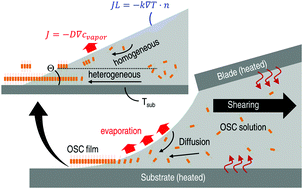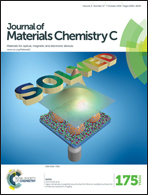A simulation-assisted solution-processing method for a large-area, high-performance C10-DNTT organic semiconductor crystal†
Abstract
A quasi-equilibrium low-speed solution shearing method to deposit C10-DNTT is developed. We focus on quantifying the effects of the key parameters, including the temperature, surface energy and receding speed of the contact line to understand the crystallization mechanisms. A finite element model that takes into consideration fluid dynamics, heat transfer and mass diffusion has been developed to simulate the experimental process. The optimized parameters obtained from the model simulation provide large-area (>1 cm2) and well-oriented crystals with high uniformity. The single crystallinity is confirmed by SAED and the fabricated devices show a high charge carrier mobility of up to 12.5 cm2 V−1 s−1 (average of 9.0 cm2 V−1 s−1) and a high on/off ratio of 2 × 109. A useful guideline on how to optimally select the experimental parameters for meniscus-guided deposition methods is provided, based on which high-quality crystals are successfully grown on a solution-processed high-k gate dielectric, which achieves mobility of up to 4.2 cm2 V−1 s−1 (an average of 3.0 cm2 V−1 s−1) in an operating range of 4 V.


 Please wait while we load your content...
Please wait while we load your content...